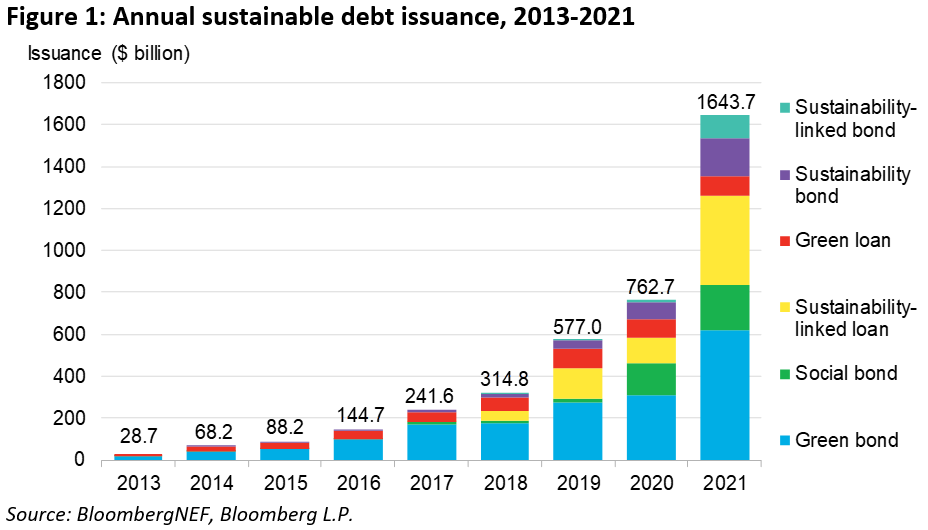Total sustainable debt issuance through 2021 exceeded $4 trillion, demonstrating the popularity of environmental, social and governance borrowing
London and New York, January 12, 2022 – Volumes of sustainable debt surpassed $1.6 trillion in 2021 alone, more than doubling 2020’s end of year value, according to data compiled by research company BloombergNEF (BNEF) for its 1H 2022 Sustainable Finance Market Outlook.
The fastest growth for sustainability themes in debt issuance last year came from sustainability-linked loans and bonds, which are instruments for which repayment is tied to the achievement of institutional environmental, social and governance (ESG) targets, such as greenhouse gas emissions reductions. These saw more than $530 billion issued in 2021 on their own, compared to only a quarter of this value in 2020. They came from industries such as financials, consumer discretionary companies and utilities.
Mallory Rutigliano, a sustainable finance associate at BNEF and lead author of the report, said: “Sustainability-linked debt instruments are becoming more and more prevalent in today’s debt market because they allow enhanced flexibility – for better or worse – than strictly project-based borrowing for ESG purposes. Though they certainly may, bonds and loans don’t even need to be earmarked for specific purposes, which allows companies to integrate their corporate sustainability targets into all kind of financing. As companies increasingly set these targets, sustainability-linked debt becomes more accessible.”
In addition to sustainability-linked instruments, sustainable debt includes funds borrowed for specific ESG projects, such as renewable energy build. Project-based borrowing is still alive and well. Green bonds, raised for environmentally beneficial activities, saw more than $620 billion in issuance in 2021. Overall, green bonds are the largest contributor to the overall sustainable debt market, making up 45% of the $4 trillion of sustainable debt issued through 2021.
Social and sustainability bonds, which finance social and community-based projects in full or combined with green objectives, also rose to new heights in 2021, reaching nearly $400 billion in combined issuance. These often target vulnerable populations and have played a key role in bolstering borrowing during the Covid-19 pandemic over the past two years.
Maia Godemer, sustainable finance associate at BNEF, commented: “The volumes of sustainable debt we are seeing on an annual basis are unprecedented. Though sustainable varieties still make up a relatively small portion of the total debt market, the $1.6 trillion in issuance in 2021 is similar to the 2020 GDP of Canada. This is not insignificant, especially as more countries begin to legislate mandates and rules related to the scaling up and standardization of sustainable finance. This shows how much financing could be unlocked to expedite our transition to a low-carbon world.”
Regulators across the globe now face the challenge posed by sustainable debt’s rise. As investors, lenders and financial participants use ESG products with aplomb, governing bodies are tasked with defining what should and should not be included under these labels, the types of disclosure required and the ways to track and audit sustainability-related statements.

BloombergNEF’s sustainable debt universe comprises green bonds, green loans, social bonds, and sustainability bonds that follow the use-of-proceeds requirements set by the International Capital Market Association (ICMA) and the Loan Market Association (LMA). The universe includes sustainability-linked bonds and loans that follow the guidelines set by the ICMA and the LMA.
BNEF’s Sustainable Finance Market Outlook is published semi-annually. Its sustainable debt data is updated on a monthly basis.
Contact
Veronika Henze
BloombergNEF
+1-646-324-1596
vhenze@bloomberg.net